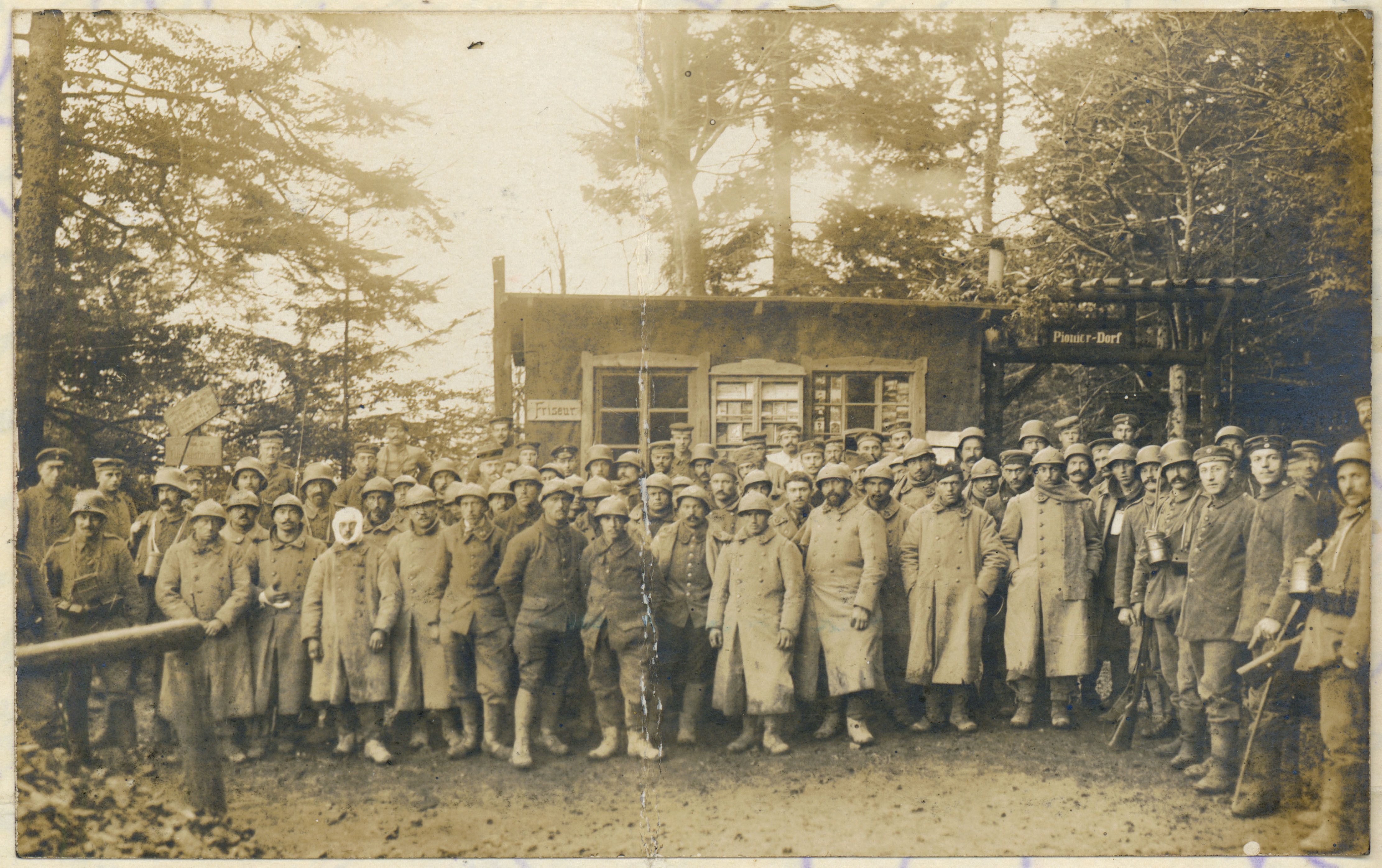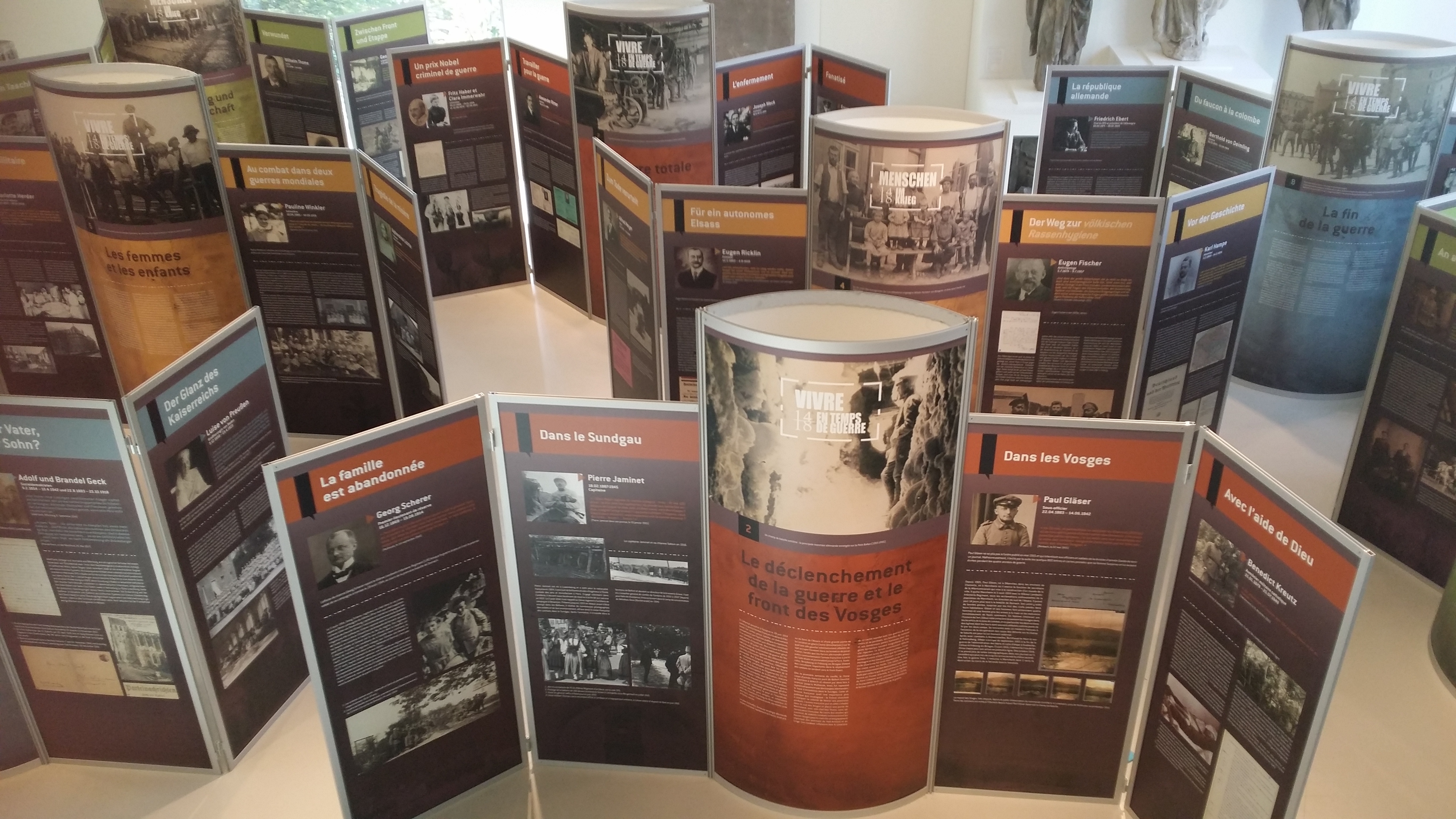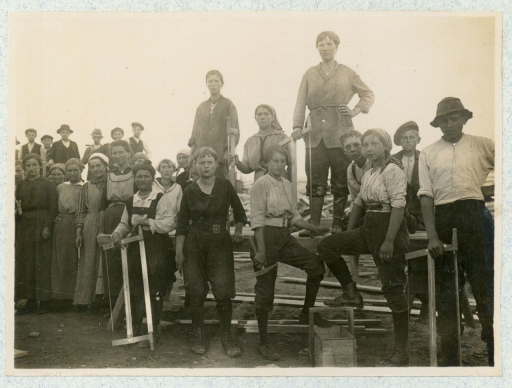CN writer, Katherine Quinlan-Flatter, reports from Baden-Baden on a touring cross-border exhibition of life in the frontier region of Baden, Germany and Alsace, France during the First World War. ‘People in the 1914-1918 War in the Upper Rhine Region’ is presented in both German and French and will ultimately travel to Paris and Berlin.
The goal of this thought-provoking exhibition is to put an end to biased, nationalistic perceptions and to develop a common historical and European awareness. Rather than addressing traditionally national or military issues of the First World War, the exhibition aims to communicate a new, different history of the war to today’s youth.
To this end, it focuses on the Upper Rhine Region, in which both the war zone and the home front were inextricably meshed, while at the same time placing individual persons from Baden and Alsace in the foreground.
The exhibition is mounted on nine multi-panelled boards – one introductory board and eight theme boards, all focusing on a particular aspect of the war or a social group.
Each board is bilingual, with German texts and photos on one side and the corresponding French on the other. They address their respective leitmotivs by focusing on four specific stories of people in the First World War, together with a biography and a photo, thus personifying the themes and bringing them to life.

Marked by battle: German and French soldiers at Hartmannsweilerkopf on November 10th, 1917 (© Generallandesarchiv Karlsruhe 456 F 65_0 Foto 3)
The introductory board displays a photo of French prisoners and their German guards at the Hartmannsweilerkopf in Alsace in 1917. This point on the Western Front serves as a microcosm of the entire conflict and reflects the character of the war, with its trench warfare and heavy losses. A contemporary map of the controversial German-French border region of Alsace is also shown.
In the wake of the Franco-Prussian War of 1870/71, France had ceded most of Alsace and parts of Lorraine to Germany, and the people in these regions, as a result of their dual history, suffered from the problems of a controversial national identity.
In early August 1914, before war had been declared, the French attacked German territory, breaking through the border at Altmünsterol in Alsace (today Montreux-Vieux in France). The first casualties were suffered on August 2nd, and Germany declared war on France the following day.
The French started an offensive at Belfort in the Franche-Comté region, and set up headquarters at Thann, thus turning this previously German border region into French territory, and the conflict on the Western Front played out at the Alsace border in the Upper Rhine region. Here it remained more or less immobilised for the next four years, with the mountain peak Hartmannsweilerkopf becoming the key position in the southern Vosges.
The first of the theme boards is called “A Militarised Society” and personifies its topic with stories including those of Grand Duchess Luise of Baden and the Governor of Alsace-Lorraine, Hermann Prince of Hohenlohe-Langenburg.

The “empire state” of Alsace-Lorraine was under the rule of the Governor, who answered directly to the Kaiser. Germany’s paradoxical character in the pre-war period was characterised on the one hand by extreme militarism and on the other by a highly modernised industry, fleet and colonies. In the context of the time, these were cutting-edge perspectives.
The second board is titled “Outbreak of War and the Vosges Front”. It features German army officers and chaplain Benedict Kreutz, together with excerpts from his diary.
Kreutz was responsible not only for German soldiers but was also confronted with the burial of many Rumanian prisoners, victims of undernourishment and general ill health. Although international directives on the treatment of prisoners-of-war existed at this time, they frequently went unobserved, and the photo of a Rumanian prisoner bears a strong resemblance to those of victims of the Holocaust during the Second World War.
The third theme board “Soldiers” includes the story of two brothers from Alsace, one who served in the German army and the other in the French.
Soldiers from Alsace were in a difficult position, as they usually came from families whose older members had originally been French citizens. It was difficult to know where their true loyalties might lie, and they were thus usually positioned at the Eastern Front, far away from the theatre of war with France. In addition, it was difficult for them to be granted leave.
Civilians
The theme of the fourth board is “Civilians” and highlights German politician Eugen Ricklin, who campaigned for the recognition of the empire state Alsace-Lorraine as an equal state in the German Empire and who was attacked for being an enemy of Germany.
It also tells the story of German anthropologist Eugen Fischer, who examined Russian prisoners in the Heuberg POW camp as part of the theory of purification of the national body, thus laying the first elements of racial discrimination followed under the National Socialist regime.
“Women and Children” is the leitmotiv of the fifth board, which includes the biography of Alphonsine Lichtle of Alsace, who, unable to support her children after her husband had been called up, turned to prostitution and contracted syphilis, for which she was interned in a prison camp as a danger to the safety of the German Empire.
Another story in this category deals with the victims of a French air attack on Freiburg in 1915, which killed seven children and one adult. The dead were photographed in highly decorated open caskets and the story was publicised in a manner evocative of today’s new media.
The sixth board covers “Prisoners and Wounded”, and tells of the German soldier Wilhelm Thome who, despite being admitted to hospital due to nervous disorders as the result of an artillery hit, was returned to the Front as “healed”. At Verdun, he then suffered such severe injuries to the head that a part of his brain had to be removed.
The board also relates the story of a soldier so mentally damaged by the war that he was subsequently admitted twelve times to psychiatric hospitals. Many soldiers suffering from nervous symptoms were ultimately sterilised or given electric shock treatment in psychiatric clinics.
Gas
The German chemist responsible for developing the poison gas used at the Front is featured in the seventh board “Total War”. Fritz Haber carried out pioneering research into industrial chemistry at the University of Karlsruhe.
Haber, who was Jewish, converted to Christianity, realising this would have advantages for his career in Imperial Germany. He was awarded the Nobel Prize in 1919 for his development of ammonia synthesis for agricultural fertilizer.
However, this was also deployed for the production of the poison gas used in the trenches to bring about death by pulmonary oedema. When his wife Clara discovered how her husband’s invention was being used, she committed suicide. Haber, despite his conversion to Christianity, was persecuted in the Third Reich and emigrated to England. He died in 1934, ironically of pulmonary oedema.
The final board “End of the War” includes Friedrich Ebert, the President of Germany following the War, and General Berthold von Deimling, who was accused of waging his own private war, but who later campaigned for the German Peace Movement.
The final biography is that of the bilingual author René Schickele, who considered the main task of his work to be mediation between the German and French cultures, in order to provide a better understanding of the dual culture of Alsace.
With its many personal stories, the exhibition succeeds in giving those men and women portrayed here a face and a voice. It is also specifically designed for presentation to older schoolchildren, and free entry to the exhibition, as well as free instructive tours are offered to groups of pupils.
Future locations and dates of the exhibition “Menschen im Krieg 1914-1918 am Oberrhein/Vivre en temps de guerre des deux côtes du Rhin 1914-1918” can be viewed here.
The exhibition opened in March 2014 in Karlsruhe, Baden and a month later in Colmar, Alsace. Since August 2014 it’s been touring various towns in the Upper Rhine, before going to Paris and Berlin.
The organisers are the Generallandesarchiv Karlsruhe, Staatsarchiv Freiburg and the Archives Départementales du Haut-Rhin in Colmar.
© Centenary Digital Ltd & Author
Archive images: courtesy of ©Generallandesarchiv Karlsruhe
